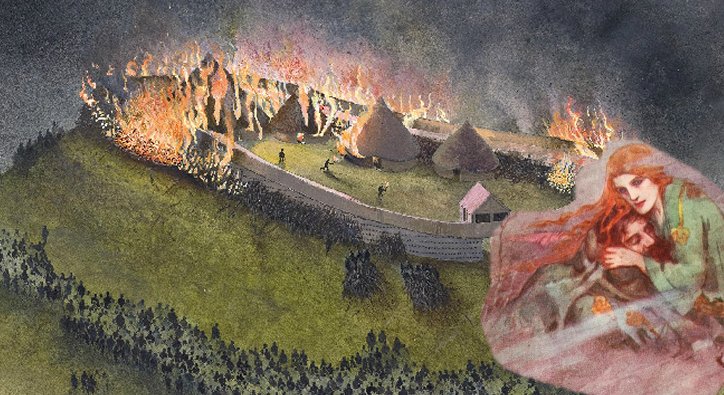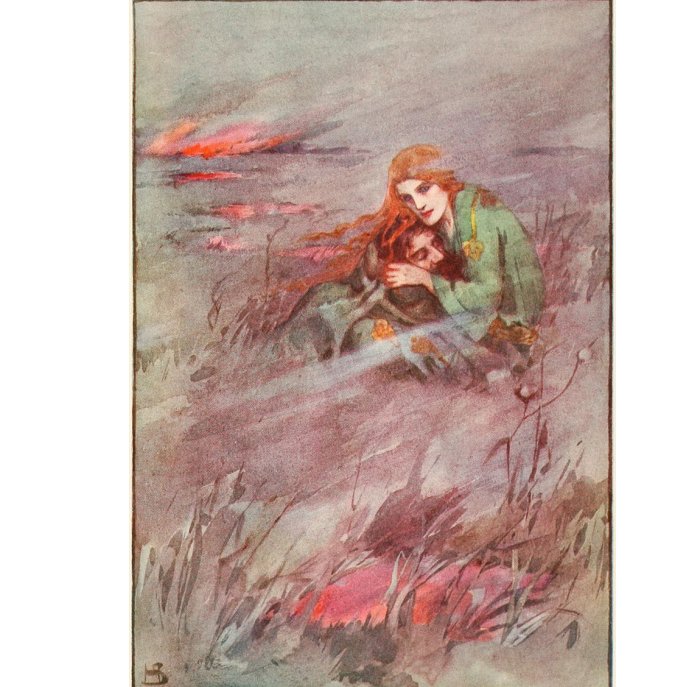Mystery Of Vitrified Scottish Fort Dun Deardail And Ancient Myth Deirdre Of The Sorrows: Is There A Prehistoric Connection?
Ellen Lloyd - AncientPages.com - Standing on a spectacular hilltop in Glen Nevis, to the west of Ben Nevis, we find Dun Deardail, a mysterious, ancient vitrified Scottish fort.
Why fort Dun Deardail was built, who built it, and when it was constructed remains an ancient mystery, but some have suggested the answers can be found in an ancient myth called the Deirdre of the Sorrows.
Why was Dun Deardail destroyed?
Sometimes, ancient myths and legends can cast more light on mysterious buildings, places, and lost prehistoric civilizations. Can the myth Deirdre Of The Sorrows unravel the ancient mystery of Dun Deardail?
Why Is Dun Deardail Vitrified?
The age and purpose of Dun Deardail are unknown, but scientists think it was probably built in the first millennium BC, although it may have been occupied and reused on several occasions through time.
The fort is vitrified, which means that its wooden and stone defenses were burned at such high temperatures and for such a long time that the stone fused together.
The fort was built on a knoll among the mountains of Glen Nevis. Image credit: Nevis Landscape Partnership
There are many vitrified forts across Scotland, and scientists have long speculated about the cause of vitrification. It was previously thought the process was either unintentional or resulted from an accident or attack. However, experimental archaeology has shown that vitrification occurs only after long burning periods: the fires must have been fed and stoked, suggesting that vitrification was an intentional process.
Very little is known about Dun Deardail because scientists have properly investigated the vitrified fort. The first archaeological expedition started in 2015 when Nevis Landscape Partnership broke new ground at Dun Deardail. A team of volunteers conducted the first excavations of this enigmatic site with the support of AOC Archaeology Group (AOC) archaeologists.
The partnership was a five-year £3.9m scheme consisting of 19 projects, and hopefully, soon, we will learn about some of the ancient secrets Dun Deardail has kept hidden for many years.
Why Dun Deardail is vitrified is unknown, but according to Forestry Commission Scotland archaeologist Matt Ritchie, there were many probable causes for the fire at Dun Deardail, including its Iron Age residents ritualistically setting the structure ablaze.
A reconstruction of what the hill fort looked like when the fire broke out at the site, caused the vitrification of its rock defenses. Image credit: Chris Mitchell
"It could be anything from an accidental fire to deliberate destruction.
Perhaps at the death of the tribal chief or king, they burned the hill fort in the same way the Vikings may have burned the longboats of a chief, or it is deliberate destruction during warfare,” Matt Ritchie said.
The Ancient Irish Myth Of Deirdre Of The Sorrows
It has also been suggested that the name of Lochaber's hill fort may be linked with an ancient Irish myth called Deirdre of the Sorrows. It is a tragic tale of the beautiful Deirdre, and the myth has been told for over 2,000 years.
Deirdre of the Sorrows is part of the Ulster Cycle of Irish Myths. It is the last of 'The Three Sorrowful Tales of Erin'.
The legend tells that before Deirdre was born, the chief druid Cathbad foretold that her incredible beauty would lead kings, lords, and warriors to fight and die for her love, trying to win her hand in marriage.
Deirdre’s father was Fedlimid Mac Daill, the royal storyteller who told wonderful tales at the court of Conchobar mac Nessa, King of Ulster.
When King Conchobar learned of the druid’s prophesy, he decided to have Deirdre raised in seclusion.
Helen Stratton - A book of myths (1915) New York : G. P. Putnam's sons; London, T. C. & E. C. Jack. Copy at New York Public Library.
As time passed, Deirdre grew into a beautiful young woman the druid Cathbad's prophesy began to come true. Kings, noble warriors, and lords battled, bled, and died for the beautiful Deirdre.
King Conchobar had no intention of letting Deirdre go and planned to marry her when she was older. Deidre was brought up in isolation by Leabharcham, a poet and wise woman. As a young girl living isolated in the woodlands, Deirdre, one snowy day, told Leabharcham that she would love a man with the colors she had seen when a raven landed in the snow with its prey: hair the color of the raven, skin as white as snow, and cheeks as red as blood.
Leabharcham told her she was describing Naoise, a handsome young warrior, hunter, and singer at Conchobar's court. When Deidre and Naoise met one day, they fell in love and accompanied by Naoise’s brothers Ardan and Ainnlethey fled to Scotland, where they lived a happy life.
But the furious, humiliated King Conchobar tracked them down and sent Fergus mac Róich to them with an invitation to return and Fergus's own promise of safe conduct home, but on the way back to Emain Macha Conchobar had Fergus waylaid, forced by his personal geis (an obligation) to accept an invitation to a feast.
Fergus sent Deirdre and the sons of Uisnech on to Emain Macha with his son to protect them. When they arrived, Conchobar sent Leabharcham to spy on Deirdre to see if she had lost her beauty.
Leabharcham wanted to protect Deirdre. She lied and told the king that Deirdre was now ugly and aged. Unfortunately, King was not convinced, and he sent another spy, Gelbann, who managed to catch a glimpse of Deirdre but was seen by Naoise, who threw a gold chess piece at him and put out his eye.
The spy managed to get back to Conchobar, and told him that Deirdre was as beautiful as ever. Conchobar called his warriors to attack the Red Branch house where Deirdre and the sons of Uisnech were lodging. Naoise and his brothers fought valiantly, aided by a few Red Branch warriors, before Conchobar evoked their oath of loyalty to him and had Deirdre dragged to his side. At this point, Éogan mac Durthacht threw a spear, killing Naoise, and his brothers were killed shortly after.
Fergus and his men arrived after the battle. Fergus was outraged by this betrayal of his word and went into exile in Connacht. He later fought against Ulster for Ailill and Medb in the war of the Táin Bó Cúailnge (the Cattle Raid of Cooley), the Irish Iliad.
After the death of Naoise, Conchobar took Deirdre as his wife. As we all know, love cannot be bought or forced. After a year, angered by Deirdre's continuing coldness toward him, Conchobar asked her whom in the world she hated the most, besides himself. She answered "Éogan mac Durthacht," the man who had murdered Naoise. Conchobar said that he would give her to Éogan. As she was being taken to Éogan, Conchobar taunted her, saying she looked like a ewe between two rams. At this, Deirdre threw herself from the chariot, dashing her head to pieces against a rock.
Is it possible the battles took place at the fort of Dun Deardail? When archaeologists excavate the site, will they then find the skeletons of the ancient kings, warriors, and lords who battled to win Deirdre’s heart? Will they find the ancient skeleton of Naoise and his brothers?
We don’t know, but maybe time and future archaeological excavations will help find an answer to these intriguing questions.
Written by Ellen Lloyd – AncientPages.com
Updated on September 5, 2022
Copyright © AncientPages.com All rights reserved. This material may not be published, broadcast, rewritten or redistributed in whole or part without the express written permission of AncientPages.com
More From Ancient Pages
-
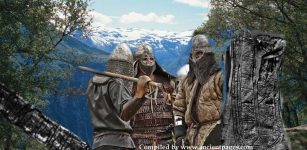 Bryggen Inscriptions Reveal Viking Runes Were Used As Modern SMS – Short Message Service In The Norse World Was Popular
Artifacts | Mar 5, 2018
Bryggen Inscriptions Reveal Viking Runes Were Used As Modern SMS – Short Message Service In The Norse World Was Popular
Artifacts | Mar 5, 2018 -
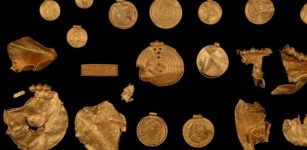 3D Scan Will Uncover Secrets Of The Magnificent Vindelev Gold Treasure
Archaeology | Oct 25, 2023
3D Scan Will Uncover Secrets Of The Magnificent Vindelev Gold Treasure
Archaeology | Oct 25, 2023 -
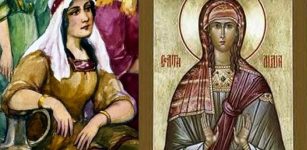 Biblical Lydia ‘Woman Of Purple’ Who Run Her Own Business
Biblical Mysteries | Apr 9, 2019
Biblical Lydia ‘Woman Of Purple’ Who Run Her Own Business
Biblical Mysteries | Apr 9, 2019 -
 Halloween: Facts And History About All Hallows’ Eve And Its Connection With Samhain – An Ancient Celtic Festival
Ancient Traditions And Customs | Oct 31, 2021
Halloween: Facts And History About All Hallows’ Eve And Its Connection With Samhain – An Ancient Celtic Festival
Ancient Traditions And Customs | Oct 31, 2021 -
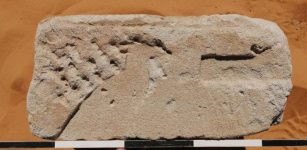 Hieroglyphs Discovered In Sudan’s Old Dongola – Once Important City Of Nubia
Archaeology | Mar 6, 2023
Hieroglyphs Discovered In Sudan’s Old Dongola – Once Important City Of Nubia
Archaeology | Mar 6, 2023 -
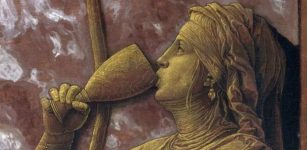 What Happened To Drunken Women In Ancient Rome?
Featured Stories | Aug 30, 2023
What Happened To Drunken Women In Ancient Rome?
Featured Stories | Aug 30, 2023 -
 USC Archeologist Discovers Maya Royal Burial Site
Archaeology | Jan 9, 2016
USC Archeologist Discovers Maya Royal Burial Site
Archaeology | Jan 9, 2016 -
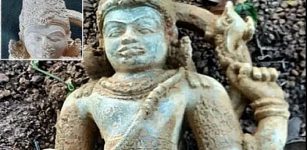 12th Century Idol Of Vishnumurthy Unearthed In Abandoned Well Near Udupi, India
Archaeology | Feb 26, 2021
12th Century Idol Of Vishnumurthy Unearthed In Abandoned Well Near Udupi, India
Archaeology | Feb 26, 2021 -
 Nicolas Bourbaki: The Greatest Mathematician Who Never Was
Featured Stories | Dec 24, 2019
Nicolas Bourbaki: The Greatest Mathematician Who Never Was
Featured Stories | Dec 24, 2019 -
 Cosmic Rays Reveal Mysterious Void Inside Great Pyramid – What’s Hiding Inside?
Archaeology | Nov 2, 2017
Cosmic Rays Reveal Mysterious Void Inside Great Pyramid – What’s Hiding Inside?
Archaeology | Nov 2, 2017 -
 Those Who Mysteriously Disappeared To A World Beyond Human Understanding
Featured Stories | Apr 30, 2019
Those Who Mysteriously Disappeared To A World Beyond Human Understanding
Featured Stories | Apr 30, 2019 -
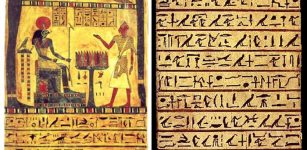 Strange History Of Stele Of Ankh-ef-en-Khonsu – ‘Stele Of Revealing’ Gave Birth To Thelema, A New Religion
Artifacts | Apr 3, 2018
Strange History Of Stele Of Ankh-ef-en-Khonsu – ‘Stele Of Revealing’ Gave Birth To Thelema, A New Religion
Artifacts | Apr 3, 2018 -
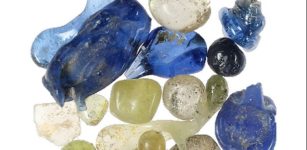 Traditional Viking-Age Crafts: Glass Beadmakers And Their Secrets
Archaeology | Oct 4, 2022
Traditional Viking-Age Crafts: Glass Beadmakers And Their Secrets
Archaeology | Oct 4, 2022 -
 Face Of Neanderthal Who Lived 56,000 Years Ago Reconstructed
Archaeology | Nov 10, 2023
Face Of Neanderthal Who Lived 56,000 Years Ago Reconstructed
Archaeology | Nov 10, 2023 -
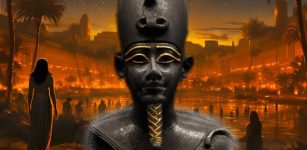 Aaru – Field Of Reeds: Kingdom Of Osiris Was The Ancient Egyptian Paradise
Featured Stories | Feb 29, 2024
Aaru – Field Of Reeds: Kingdom Of Osiris Was The Ancient Egyptian Paradise
Featured Stories | Feb 29, 2024 -
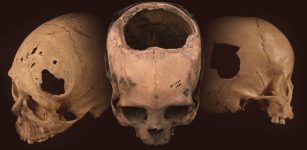 Ancient Peru’s Cranial Surgeons Had Remarkable Skills
Ancient Technology | Jun 8, 2018
Ancient Peru’s Cranial Surgeons Had Remarkable Skills
Ancient Technology | Jun 8, 2018 -
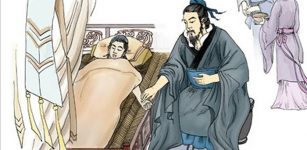 2,000 Year-Old Books Written By Bian Que The Divine Healer Unearthed
Artifacts | May 13, 2014
2,000 Year-Old Books Written By Bian Que The Divine Healer Unearthed
Artifacts | May 13, 2014 -
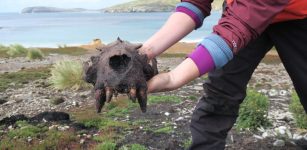 Surprising Evidence Of Prehistoric Human Activity In Falkland Islands – Europeans Were Not The First Settlers
Archaeology | Oct 29, 2021
Surprising Evidence Of Prehistoric Human Activity In Falkland Islands – Europeans Were Not The First Settlers
Archaeology | Oct 29, 2021 -
 Soyal: Hopi Indians’ Winter Solstice Celebration And Arrival Of Katchinas
Ancient Traditions And Customs | Mar 29, 2019
Soyal: Hopi Indians’ Winter Solstice Celebration And Arrival Of Katchinas
Ancient Traditions And Customs | Mar 29, 2019 -
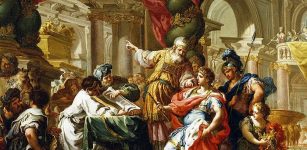 Alexander The Great’s Biblical Connection
Featured Stories | May 29, 2019
Alexander The Great’s Biblical Connection
Featured Stories | May 29, 2019

